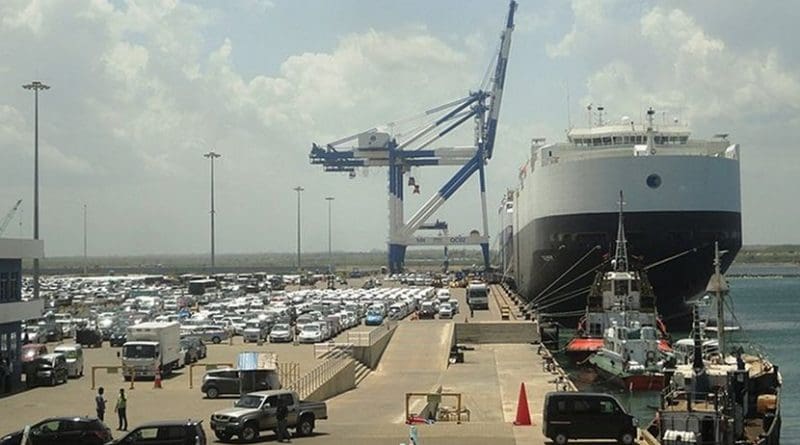Sri Lanka’s Hambantota Gambit – Analysis
By Observer Research Foundation
Sri Lanka’s pact with China for Hambanbota port may well be a case of strategic deception, and not just a political balancing act between India and China.
By Abhijit Singh
Late last month, Colombo inked a revised version of a $1.1 billion deal for leasing the Hambantota port to a Chinese state-run company. The port has been controversial ever since the China Merchants Port Holdings (CMPort) signed a framework agreement in December 2016 with Sri Lanka, taking an 80% stake in the project. Following the deal, however, there was much domestic unrest and accusations by Sri Lanka’s opposition parties of a sell-out to China, forcing Colombo to reconsider its position.
Sri Lanka also recognised regional concerns that Chinese control of Hambantota would result in its greater use by the People’s Liberation Army Navy (PLAN). In particular, Colombo empathised with a growing sense in New Delhi that China’s expanding naval presence in South Asia represented a deliberate violation of India’s strategic redlines.
Sri Lankan leaders say the new deal corrects all that was wrong with the 2016 agreement. Besides restricting CMPort’s stakes to 70% (the lease period remaining at 99 years), Colombo has ensured that the port will not be used for military purposes. The pact limits CHPort’s role in running commercial operations by splitting the administrative functions between two companies. With a capital of $794 million, Hambantota International Port Group (HIPG) will run operations at the port and its terminals. Controlled by CMPort, it will hold an 85% stake, with the rest held by Sri Lanka Ports Authority (SLPA). The second company, Hambantota International Port Group Services (HIPS), will have a capital investment of $606 million and oversee security operations, with the SLPA holding a 50.7% stake and CHPort, 49.3%. Colombo says the agreement gives it full control over security matters, as also the right to inspect ships entering the port.
Yet, there may be more to the agreement than meets the eye. On the day of the pact’s signing, a CMPort press release stated that 58% of the total amount invested was for the creation of HIPS, with $146.34 million put into a bank account to cover operational expenses. This is seemingly inconsistent with Sri Lanka’s claims that Colombo has majority holding in the second firm, with a controlling interest. Moreover, out of 50.7% held by the SLPA in HIPS, 8.7% will be from HIPG, which is fully controlled by CMPort. SLPA’s real stakes then amount to less than 50.7%, with majority shares belonging to HIPG, in which CMPort has an 85% stake. In effect, therefore, Hambantota remains well under the control of the Chinese firm, whose majority stakes ensure control over ship movements, including those of Chinese war vessels.
There is also the likelihood of potential overlaps in authority and jurisdiction between the two controlling firms at Hambantota. As per existing port management norms, the company that controls operations takes decisions on how ships must enter and leave harbour. At Hambantota, HIPS’ right to control warship movements may result in a clash of authority with CMPort, the majority stakeholder.
The Chinese are likely to have anticipated these problems and inserted clarifying clauses in the agreement that recognise CMPort’s final authority in case of a disagreement with HIPS. But the relevant sections haven’t been made public. Indeed, the Sri Lankan government’s inability to place the agreement in parliament for discussions does lead to the suspicion that only select portions of the pact have been revealed.
In expressing their apprehensions, Indian commentators recall the docking of a Chinese submarine at Colombo in 2014. The PLAN submarine should have berthed at an SLPA berth, in accordance with Sri Lankan regulation that stipulates foreign military vessels be accommodated at state-owned facilities. But the submarine came alongside the deep-water Colombo South Container Terminal, a facility built, controlled and run by CMPort, which now also controls Hambantota.
India’s security establishment cannot ignore Sri Lanka’s critical position in South Asia, astride key regional sea-lanes, making it a prime logistics hub for Chinese war vessels. In the past, PLAN ships are known to have silently slipped in and out of Sri Lankan waters, in contrast to the very public visits by warships from other countries. The paucity of military replenishment sites along the principal sea-lanes in the Eastern Indian Ocean has prompted Beijing to nurture a special relationship with Colombo.
The Sri Lankan government’s de facto moratorium on the docking of Chinese warships and submarines at Hambantota, though well intended, is unlikely to endure in the long run. China is bound to exploit deliberate ambiguities in the agreement to utilise Sri Lankan ports for military replenishment purposes. Whatever the circumstances, Indian observers know Beijing will not let New Delhi’s security concerns override Chinese interests in the littoral seas.
The true nature of Sri Lanka’s pact with China at Hambantota will only be revealed through a close reading of its original document. Regardless of what Colombo professes, India will be wary about the agreement at Hambantota — not just in relation to the division of ownership, but also regarding the prospect that China’s possible acquisition of berthing rights at Hambantota could lead to the setting up of the PLA’s first dual-use civilian-cum-military facility in South Asia.
This article originally appeared in Live Mint.

